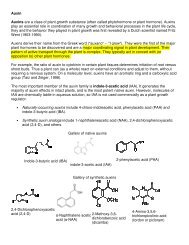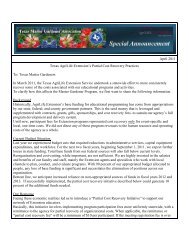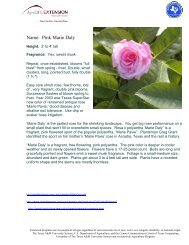Graywater - Texas Master Gardeners Association
Graywater - Texas Master Gardeners Association
Graywater - Texas Master Gardeners Association
You also want an ePaper? Increase the reach of your titles
YUMPU automatically turns print PDFs into web optimized ePapers that Google loves.
Figure 3. Components of an onsite wastewater treatment system.<br />
backing up into the graywater system.<br />
Water flowing in the desired direction<br />
has enough pressure to lift the flap of<br />
the backwater valve and pass through<br />
it, but sewage flowing the wrong way<br />
forces the flap to stay closed. Two<br />
valves are used as a precautionary<br />
measure, so that just in case one fails,<br />
sewage still cannot back up into the<br />
graywater system.<br />
<strong>Graywater</strong> can be collected,<br />
treated, stored and reused. The type of<br />
wastewater-treatment system chosen<br />
depends on the constituents present in<br />
the graywater and on the level of treatment<br />
desired. In some cases, a settling<br />
tank with a gravity-fed pipe to the<br />
distribution system may be adequate<br />
(Fig. 6). In other cases, graywater can<br />
be sent to a secondary tank from which<br />
Figure 4. Diverted graywater plumbing system.<br />
Diverted plumbing systems require<br />
separate management of blackwater<br />
and graywater sources. Because graywater<br />
systems may be used seasonally,<br />
may need periodic maintenance, or<br />
may be abandoned in the future, a diversion<br />
valve should be placed in the<br />
graywater collection line at the point<br />
where it leaves the residence (Fig. 4).<br />
This diversion valve allows graywater<br />
flow to be directed to the graywater<br />
system or to the onsite wastewater<br />
treatment system (OWTS). If a<br />
residence is connected to a municipal<br />
wastewater treatment system, the<br />
diversion valve will direct graywater<br />
either to the graywater system or to<br />
the municipal collection system.<br />
Overflow from the graywater<br />
system must be diverted to the onsite<br />
wastewater treatment system or to the<br />
municipal system, but two backwater<br />
valves must be installed. A backwater<br />
valve (Fig. 5) allows water to flow<br />
one way (to the onsite wastewater<br />
treatment system or to a municipal<br />
sewer) but prevents effluent from<br />
Figure 5. Backwater valve for<br />
plumb-ing into graywater system<br />
overflow line.<br />
Figure 6. Settling tank for gravity<br />
graywater-distribution system.<br />
it will be pumped to a pressurized<br />
subsurface reuse system (Fig. 7). In a<br />
pressurized system, discharge is regulated<br />
to control graywater application.<br />
Such control can be important when<br />
graywater is reused for irrigation.<br />
With either design, an overflow<br />
pipe must be installed to divert excess<br />
water to the onsite wastewater treatment<br />
system or to the municipal sewer<br />
system. When an onsite wastewater<br />
treatment system is used, however, it<br />
may be easier to treat all wastewater<br />
from a residence for reuse rather than<br />
treat graywater separately. A decision<br />
to divert, collect or treat graywater
















